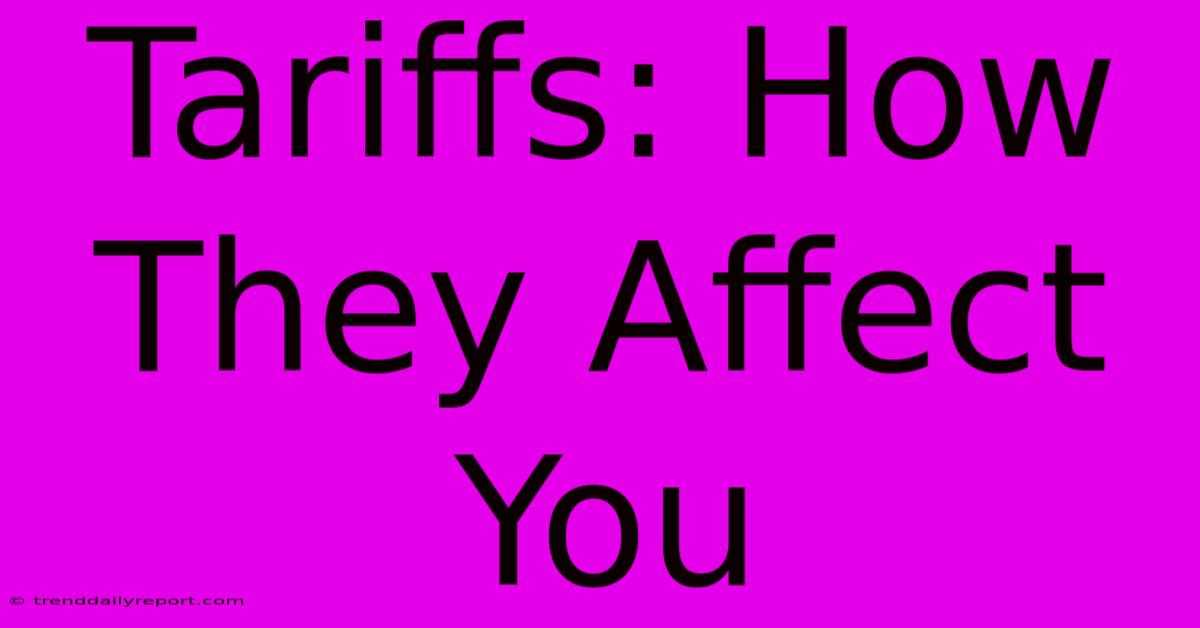Tariffs: How They Affect You

Discover more detailed and exciting information on our website. Click the link below to start your adventure: Visit Best Website Tariffs: How They Affect You. Don't miss out!
Table of Contents
Tariffs: How They Affect You – A Real-Life Look
Hey everyone, so we're diving into tariffs today. It's a topic that sounds super boring, right? Like, economics class all over again. But trust me, tariffs totally affect you, even if you don't realize it. I mean, I sure didn't until I really dug into it.
My "Aha!" Moment with Tariffs
A few years back, I was obsessed with finding the perfect pair of hiking boots. Seriously, I spent months comparing prices, reading reviews – the whole shebang. I finally found a killer deal on a pair from Italy. They were gorgeous, top-notch leather, and the price was amazing. Then, BAM! Suddenly, the price jumped up by like 30 bucks! Turns out, there was a new tariff on imported footwear. That extra $30? That was a tariff. Ouch!
That's when the lightbulb went off. Tariffs aren't just some abstract economic policy. They're real-world price increases that can impact what you buy, and how much you pay for it. And that, my friends, is why we need to understand them better.
What Exactly Are Tariffs?
Think of tariffs as taxes on imported goods. Governments impose them for various reasons – to protect domestic industries, to retaliate against other countries, or even to increase government revenue. These tariffs are added to the initial price of imported products, increasing the total cost for consumers.
It's simple: a tariff on imported steel means higher prices for cars, appliances, and construction materials – things that use steel in their manufacturing. A tariff on clothing? Yep, that affects the cost of your jeans and t-shirts. So, it's not just about those fancy hiking boots! It’s about everything.
Types of Tariffs
There are a few different types of tariffs, and it's good to know the difference. You have specific tariffs, where a fixed amount of money is added per unit. Then there are ad valorem tariffs, which are a percentage of the imported goods' value. And finally, there are compound tariffs, which combine both. It’s a bit like a tax maze sometimes.
How Tariffs Impact Your Wallet
Okay, so we know tariffs raise prices. But how much do they raise prices? That depends on a lot of things: the size of the tariff, the demand for the product, and how much of that product is imported versus domestically produced. Sometimes, the increase is small and barely noticeable. But other times, like with my Italian boots, the effect is a significant hit to your budget.
It's not just about the direct price increase, either. Higher prices can lead to reduced consumer spending. If things cost more, people might buy less of them – which can hurt businesses and the economy as a whole. It's a ripple effect!
The Impact on Businesses
Businesses are on the front line of tariff impacts, too. If a company imports raw materials, a tariff increase can directly affect their production costs. These costs are then often passed on to the consumer via higher prices. It's a tough situation for everyone involved, really. Businesses might also see a drop in sales if their goods become too expensive.
What Can You Do?
So, what's a consumer to do? Well, being informed is the first step. Keep an eye on the news – especially trade news – and try to understand how tariffs might affect the things you buy. You can also support businesses that manufacture domestically to lessen your dependence on imported goods and the tariffs that come with them. I know, it’s not always easy, but it's something to keep in mind.
Ultimately, tariffs are complex, and the impacts can be nuanced and far-reaching. But understanding the basics can help you make more informed decisions about your spending and your support for local businesses. This understanding helped me to be more mindful of the costs of things I purchase.
Remember that hiking boot story? It might seem small, but it was my wake-up call about tariffs and their impact. Hopefully, this little peek into the world of tariffs has been helpful! Let me know what you think, and feel free to share your own experiences!

Thank you for visiting our website wich cover about Tariffs: How They Affect You. We hope the information provided has been useful to you. Feel free to contact us if you have any questions or need further assistance. See you next time and dont miss to bookmark.
Featured Posts
-
Slovan Vs Milan Starting Lineups
Nov 27, 2024
-
Wendy Williams Health Update Tmz Report
Nov 27, 2024
-
Havant Mp At Ucl
Nov 27, 2024
-
Slovan Milan Official Team Lineups
Nov 27, 2024
-
Tributes Paid To Gemma Hussey 86
Nov 27, 2024
